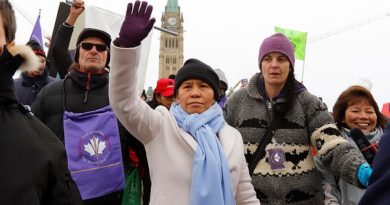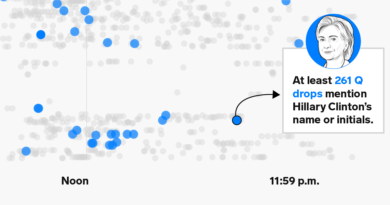How QAnon conspiracy theory became an ‘acceptable’ option in marketplace of ideas — and more lessons on fake news

The material comes from the project’s newsletter, the Sift, which takes the most recent viral rumors, conspiracy theories, hoaxes and journalistic ethics issues and turns them into timely lessons with discussion prompts and links. The Sift, which is published weekly during the school year, has more than 10,000 subscribers, most of them educators.
The News Literacy Project also offers a program called Checkology, a browser-based platform designed for students in grades six through 12 that helps prepare the next generation to easily identify misinformation. Now, during the coronavirus pandemic, the project is offering access to Checkology Premium at no cost to educators and parents in the United States. In just two weeks of the offer, more than 1,100 educators and parents in 49 states and the District have registered to use the platform with as many as 90,000 students.
You can learn more about the News Literacy Project and all of the educational resources it provides in this piece, but here is a rundown:
Founded more than a decade ago by Alan Miller, a Pulitzer Prize-winning reporter at the Los Angeles Times, the News Literacy Project is the leading provider of news literacy education.
It creates digital curriculums and other resources and works with educators and journalists to teach middle school and high school students how to recognize news and information to trust — and provides them with the tools they need to be informed and engaged participants in a democracy. It uses the standards of high-quality journalism as an aspirational yardstick against which to measure all news and information. Just as important, it provides the next generation with an appreciation of the First Amendment and the role of a free press.
Here are some earlier lessons in this series:
And here are lessons from the Monday edition of the Sift that relate to the pandemic.
QAnon faithful
Conspiracy theories about the covid-19 pandemic can be described in a variety of ways — alarming, outlandish, dangerous — but they shouldn’t be surprising.
Even the Plandemic “documentary” that suddenly swept its way across social media earlier this month did so on a path paved with fragments of pandemic conspiracy theories that were already in circulation. But as a report by Adrienne LaFrance in the June issue of the Atlantic points out, if one theory has established conspiratorial thinking as an “acceptable” option in the modern marketplace of ideas, it’s QAnon.
At its heart is the baseless notion that President Trump is secretly working to bring about a “Great Awakening” to expose an elite cabal of child sex abusers — including prominent political figures in Washington — that has been concealed by intelligence agencies, or “the deep state.”
In many ways, QAnon is a quintessential conspiracy theory: It offers its adherents simple explanations in place of complexity, a coherent entity on which to place blame for the transgressions of modern life, and a sense of control and populist purpose.
But in other ways, it seems to have tapped into deeper veins of moral gratification: an apocalyptic vision of a renewed America that resonates deeply with evangelical Christian beliefs about the End Times. (Indeed, at least one church has been founded on QAnon belief principles.)
Whether they see QAnon as prophecy, self-described “research” or an “open source intelligence operation,” its followers have grown so numerous and pushed its rhetoric so persistently on so many fronts online, that its most anodyne permutations — vague references to a coming reckoning for immoral Washington elites — are disturbingly present in mainstream discourse.
As it has grown, QAnon has expanded to absorb other conspiracy theories, explain away its own inconsistencies and incorporate new developments, such as the covid-19 pandemic. So-called wellness influencers are spreading QAnon talking points alongside posts that tout unfounded “cures” or praise “holistic living.”
And an April 8 “Q drop” — a post, said to be by Q, on an Internet message board — had this cryptic message:
Discuss: What are the characteristics of conspiratorial thinking? How can entirely baseless conspiracy theories “feel” so right to some people? What role does evidence play in conspiracy theories? Why do you think conspiracy theories tend to arise during periods of great social and economic change? How do fear and anger contribute to the belief in conspiracy theories?
Protesters heap abuse on reporter
A television reporter’s videos of an “Open New York” rally — in which he is seen beset by hostile protesters chanting “Fake news is not essential” — spread across social media last week, drawing support from fellow journalists and garnering national (and international) attention.
Kevin Vesey, a reporter for News12 Long Island, covered the May 14 event in Commack, N.Y., posting videos on Facebook Live and Twitter. While the majority of those present were peaceful, he said on Twitter, some complained about his coverage of a similar protest a couple of weeks earlier. They also approached him too closely, he said, and called him “the enemy of the people.”
“I’ll probably never forget what happened today,” Vesey said on Facebook. “I was insulted. I was berated. I was practically chased by people who refused to wear masks in the middle of a pandemic. All the while, I was there to tell THEIR story.”
In a Facebook post that evening, the Setauket Patriots, a conservative group that organized the rally, said it “would like to apologize on how you were treated,” adding the people harassing Vesey were not part of the group “in any way, shape or form.”
According to the Johns Hopkins Coronavirus Resource Center, Suffolk County, where Commack is located, had 38,117 confirmed cases of covid-19 on Monday — the seventh-largest number on the county level in the United States.
Note: Local journalism has been hit hard during the economic fallout of covid-19, with a number of news organizations worldwide laying off or furloughing staff, reducing the frequency of their print editions or shutting down altogether.
Discuss: Do you think this incident was important or significant enough to become a national news story? Why or why not? Is there a pattern of hostility toward reporters? If you think that there is, what is the cause? How do incidents like these affect press freedom in the United States?
*** This article has been archived for your research. The original version from The Washington Post can be found here ***


